 Jet Propulsion
Jet Propulsion Book contents
- Frontmatter
- Contents
- Preface
- Glossary
- Nomenclature
- Part 1 Design of Engines for a New 600-seat Aircraft
- Part 2 Engine Component Characteristics and Engine Matching
- 11 Component Characteristics
- 12 Engine Matching Off-design
- Part 3 Design of Engines for a New Fighter Aircraft
- Part 4 Return to the Civil Transport Engine
- Appendix: Noise and its Regulation
- Bibliography
- References
- Index
- Design sheets for New Large Civil Aircraft and New Fighter Aircraft
12 - Engine Matching Off-design
from Part 2 - Engine Component Characteristics and Engine Matching
- Frontmatter
- Contents
- Preface
- Glossary
- Nomenclature
- Part 1 Design of Engines for a New 600-seat Aircraft
- Part 2 Engine Component Characteristics and Engine Matching
- 11 Component Characteristics
- 12 Engine Matching Off-design
- Part 3 Design of Engines for a New Fighter Aircraft
- Part 4 Return to the Civil Transport Engine
- Appendix: Noise and its Regulation
- Bibliography
- References
- Index
- Design sheets for New Large Civil Aircraft and New Fighter Aircraft
Summary
INTRODUCTION
In Chapter 11 the performance of the main aerodynamic and thermodynamic components of the engine were considered. In earlier chapters the design point of a high bypass ratio engine had been specified and a design arrived at for this condition. At the design point all the component performances would ideally fit together and only the specification of their performance at this design condition would be required. Unfortunately engine components never exactly meet their aerodynamic design specification and we need to be able to assess what effect these discrepancies have. Furthermore engines do not only operate at one non-dimensional condition, but over a range of power settings and there is great concern that the performance of the engine should be satisfactory and safe at all off-design conditions. For the engines intended for subsonic civil transport the range of critical operating conditions is relatively small, but for engines intended for high-speed propulsion, performance may be critical at several widely separated operating points.
The treatment in this chapter is deliberately approximate and lends itself to very simple estimates of performance without the need for large computers or even for much detail about the component performance. The ideas which underpin the approach adopted are physically sound and the approximations are sufficiently good that the correct trends can be predicted; if greater precision is required the method for obtaining this, and the information needed about component performance, should be clear.
- Type
- Chapter
- Information
- Jet PropulsionA Simple Guide to the Aerodynamic and Thermodynamic Design and Performance of Jet Engines, pp. 143 - 176Publisher: Cambridge University PressPrint publication year: 2003


